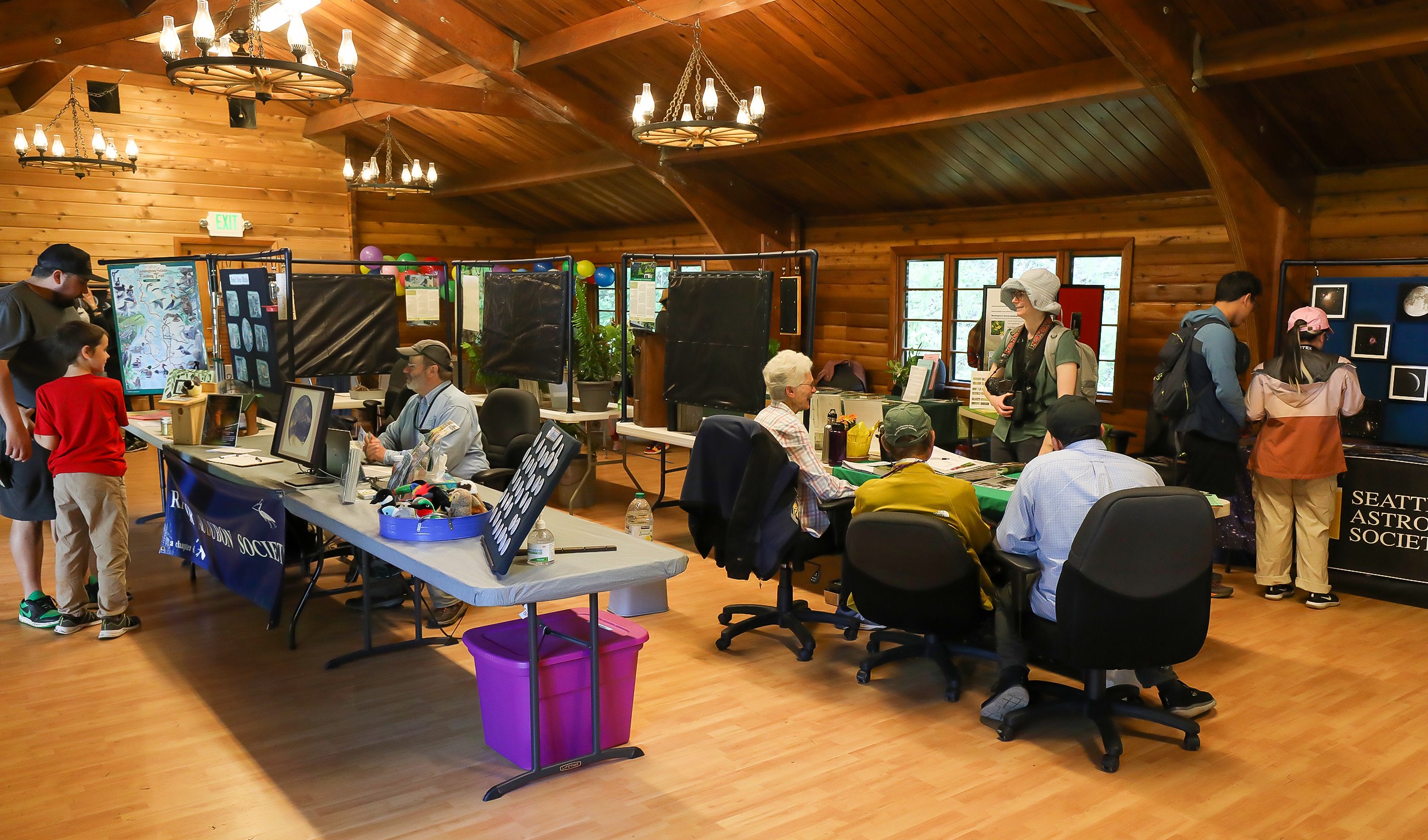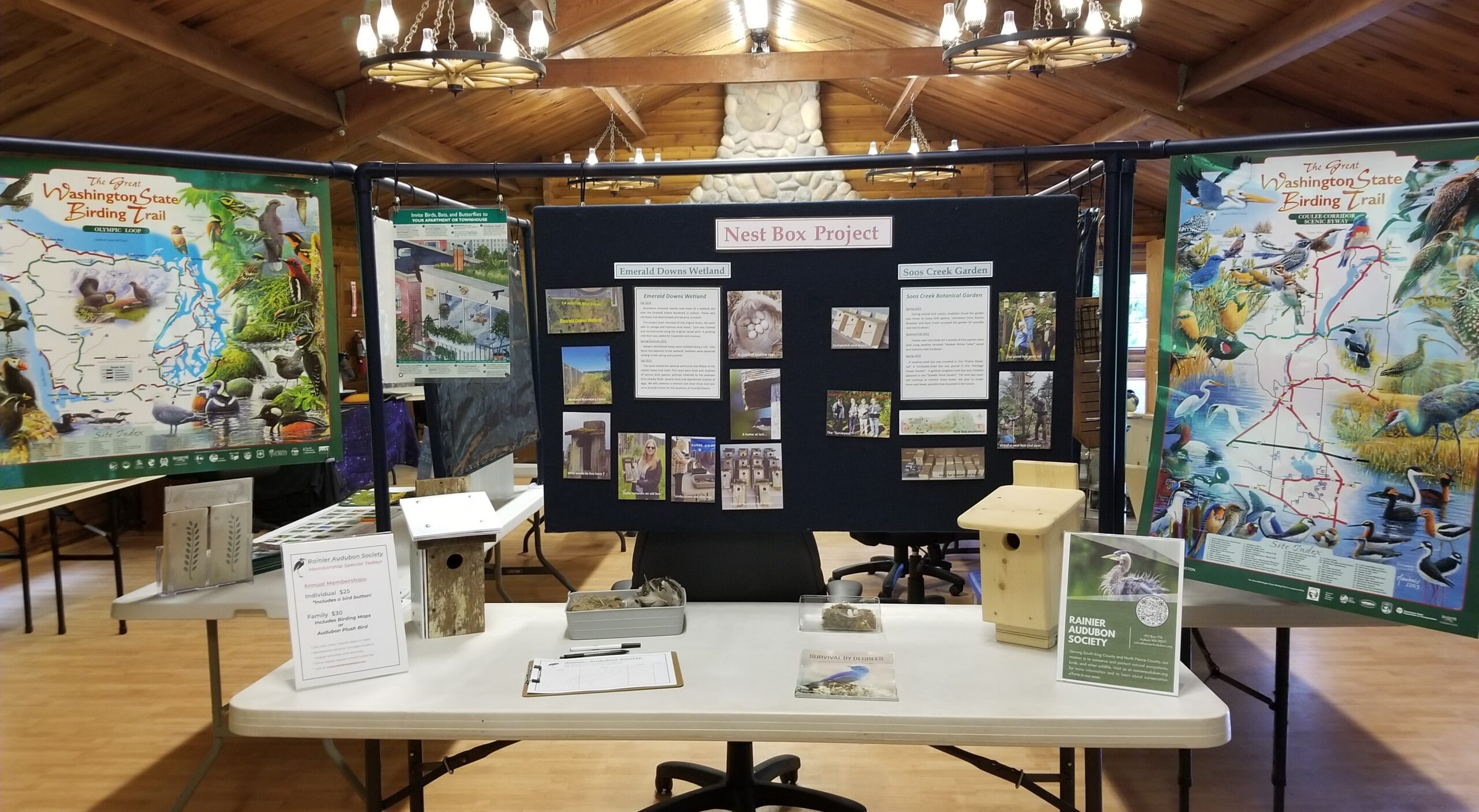
Rainier Audubon Society Chapter DRAFT Strategic Plan 2023
The Rainier Audubon Board will appreciate your review of this draft.
Please send any comments or suggestions to Robyn Singh (robyn.singh@outlook.com) or leave a comment at the bottom of this post.
Since 1978 the Rainier Audubon Society has been working towards our mission: to conserve and protect natural ecosystems, birds, and other wildlife in South King County and North Pierce County.
It all started when a handful of people collaborated to protect a Great Blue Heron rookery from development. In the mid-1970s, the rookery was discovered in the path of a planned freeway off-ramp. Tom Shaver, students from a Green River College birding class, and Federal Way resident Thais Bock began working with the state Department of Transportation to try and re-route the ramp. Their efforts were successful. The ramp was re-routed, the rookery preserved and Tom was honored with an Environmental Excellence Award for his work.
This grassroot effort became the foundation of our chapter. With the work to save the rookery it became apparent an Audubon chapter was needed to serve the area between the Seattle and Tacoma chapters. In 1978, the Rainier Chapter was granted existence by National Audubon and Tom Shaver was elected the first president.
Our 2023 Strategic Plan represents the next step for our chapter. This plan will guide our work for the coming years as we shift to a more focused approach that we hope will increase our impact in the community. Our plan is centered on four key areas:
| CONSERVATION | EDUCATION | COMMUNITY OUTREACH | CHAPTER SUSTAINABILITY |
| North Lake Photo by Dan Steiffert | Youth Naturalist Outing Photo by Cindy Flanagan | SCBG Plant Sale Photo by Ken Schroeder | Youth CBC Photo by Marie West-Johnson |
Mission
Our mission is to conserve and protect natural ecosystems, birds, and other wildlife.
Values
Our values define who we are as an organization and what is more important. We use them to guide our decisions, practices and engagement with members and the broader community.
| Stewardship | Promote the responsible use, restoration and protection of the environment through conservation and sustainable practices for resilient bird habitats. |
| Community | Provide a welcoming space where people come together, share and learn in meaningful ways that foster conservation and enjoyment of birds and the natural environment. |
| Inclusion | Achieving our goals requires the diversity of human experience, where everyone is welcome, heard and respected. |
| Reputation | We continually strive to live up to our values and fulfill our mission. |
Diversity and Inclusion
To achieve our mission to conserve and protect natural ecosystems, birds, and other wildlife, we must be inclusive of and reflect the full spectrum of human diversity. Rainier Audubon chapter strives to embrace, represent and celebrate the remarkable diversity of South King County and North Pierce County in all our conservation efforts.
Inclusion is an integral focus of our organization. We will take thoughtful and sustainable actions to build a more inclusive organization such as partnerships with organizations that are diverse, strengthening relationships with Native American Nations and engaging with diverse members as active volunteers and in leadership roles.
Land Acknowledgement
Rainier Audubon Society meets on the ancestral lands of the Duwamish, Muckleshoot and Puyallup nations, people who once lived throughout the area from the Cascades to the Salish Sea. We acknowledge past and present indigenous people as the land’s ancestral caretakers. We honor and respect the diverse modern nations as we work together toward ecosystem recovery and a more just and sustainable future.
What We Do
As an all-volunteer organization it is important to have a clear and targeted focus to achieve our vision and mission. Our strategic goals define where we will focus over the long term and guide what we will do in the coming year. Each year the Board and Committee Chairs re-evaluate our goals and set objectives that direct activities for the coming year with input from our members.
In setting goals, we reflect on what has gone well and what we would like to improve. Our members share a deep passion to conserve and protect natural ecosystems, birds, and other wildlife. We have strong relationships with other groups, communities and local and county governments, such as partnering with the King County Land Conservation Initiative to acquire 60,000 acres of high value conservation land by 2030. We have active partnerships with many similarly focused Non-Governmental Organizations (NGOs), such as the Green River Coalition which focuses on healthy waters in the Green River watershed.
Like all organizations, we face challenges we can address in our plans. Our volunteer Board covers a lot of ground and we would like to grow our Board and broaden our skillset. We see opportunities to engage more with members and to build new connections with broader groups and communities. We would like to build upon our communication with members by leveraging social media and local media to gain visibility and a wider, more diverse reach.
While our goals guide our work, we operate in an unpredictable environment that may change so our goals are a work in progress. As conditions change we may change our plans to meet new needs and to serve our members and communities long into the future.
Strategic Goal 1: Conservation
Conservation is the heart of our mission. Birds and their habitats continue to face significant risks and require immediate and collaborative action to protect and preserve them for future generations. Audubon’s scientists tell us that climate change is the greatest threat to birds. Peer-reviewed research shows that 314 species—roughly half of all North American bird species—are threatened with the loss of at least 50 percent of their habitat by 2080.
Our conservation strategy is focused on two key elements: protecting the places that birds need in a warmer world and advocating for significant public policy changes at the local, state, and federal levels. Rainier Audubon pursues conservation initiatives such as:
- Educating the public on climate issues related to birds
- Organizing work parties, field trips, and other activities to engage people in conservation
- Working with state, county, and city governments and local businesses to advance programs to reduce Greenhouse Gas emissions
- Promoting the economic benefits of clean energy technologies
- Pursuing opportunities to preserve and protect wildlife habitat
Strategic Goal 2: Education
We believe conservation starts with education. Our commitment is to inspire people to get out in nature and explore the world of birds and their habitats. We promote the knowledge and appreciation of birds and advocate for the protection, preservation, and restoration of their habitats.
Rainier Audubon provides meaningful and impactful opportunities for children and adults that foster appreciation and wonder and encourage action to care for and improve bird habitat. We will accomplish this by:
- Offering educational and conservation-related programs, events and activities, including classes, field trips, citizen science opportunities, bird festivals, and conservation projects
- Providing educational content through a range of mediums to promote access and inclusion, including in-person, online and social platforms such as YouTube and Twitter
Our content is based on National Audubon’s Five Strategic Areas:
Strategic Goal 3: Community Outreach
Achieving our conservation and education goals requires reaching out to the communities we serve to spread awareness about birds and their needs, and to ignite in people a love of birds and a desire to conserve their habitats. Our chapter is working with the City of Kent on plans for the future Green River Watershed Education Center, which would provide tremendous opportunities for community engagement, education and outreach. To further our reach and visibility, we’ll continue to:
- Partner with cities and organizations such as the City of Kent and the Environmental Science Center in Burien.
- Participate in nature-related community events such as the Tukwila Backyard Wildlife Festival and the Burien Bird Fest.
- Offer educational programs, bird surveys, and information booths for local garden sales, libraries, schools, Kent’s Green River Natural Resources Area, Auburn’s Mary Olson Farm and Soos Creek Botanical Garden.
Strategic Goal 4: Chapter Sustainability
Our vision for healthy bird populations and vibrant habitats is a long term one. For Rainier Audubon to serve our communities for generations to come, we must be responsible stewards. We are committed to managing our operations in a transparent and efficient manner, promoting responsible growth that is focused on quality over quantity, and strengthening our resilience to adapt to the changing and unpredictable circumstances in the territories we serve.
Annual Objectives and Activities
Given our strategic priorities, in 2023 we will focus on the initiatives listed below. As a fully volunteer organization, we encourage members to join a committee or contribute to any area of interest. There are several additional areas we would love to pursue but are not currently able to such as participating in school or library outreach, creating GIS maps for the Christmas Bird Count, or securing National Audubon grants. Members interested in driving these activities are welcome to contact us. To learn more, contact info@RainierAudubon.org.
Conservation
- Define our top conservation projects and how we will determine our level of participation.
- Conduct annual Christmas Bird Count (CBC) and improve CBC by adding a leader orientation meeting and an online method for submitting surveys,
- Expand our relationships with local Governments and Native American Nations to include all the local Governments and Nations in our territory.
- Identify and prioritize non-government conservation organizations with whom we will maintain active partnerships.
- Actively support conservation efforts by other organizations through Letter sign ons, surveys, etc.Identify habitat restoration projects to participate in or to sponsor.
Education
- Create an annual Education plan leveraging the National Audubon and Seattle Audubon priorities, including Monthly Program meeting, Webinars, Field Trips and Backyard Habitat Tour.
- Enrich leadership and citizen science skills, through Advancing Your Birding course and Young Birders GroupParticipate in community festivals/events and provide presentations to other groups as requested.
Community Outreach
- Inventory our current community partnerships, prioritize key partnerships and build an action plan to build or strengthen them.
- Identify the current community festivals/events held by our partners and identify the 3-5 we will participate in to maximize our reach and visibility.
- Identify 3-5 gardens within our territory and explore with them the opportunity to build or strengthen our partnership.
Chapter Sustainability
- Increase Membership by 10% from 176 to 194 and Subscribers by creating a plan to recognize those who have contributed significantly to RAS and to having an Annual General Meeting.
- Improve Chapter Financial Health by creating a 2023 annual budget and fundraising plan to increase donations and grants by 10%.
- Increase Committee participation and effectiveness by updating committee structure and creating committees for Field Trip, Education, Conservation, Membership, Financial/Audit, Governance, and Volunteer.
- Improve Board effectiveness by increasing Board size from 8 to 10-12 and creating succession plans for Officer positions.
- Improve Chapter Operations by improving the Board and Monthly Membership meetings, the chapter onboarding experience and the online access to and storage of information.
- Improve awareness of our Chapter by creating a PR and Marketing Communications Plan defining how we will manage our communication channels and increase our activity




As Barbara Petersen and I worked on a land acknowledgement, we learned that it is (or, at least, should be) just the first step in recognizing and appreciating Native stewardship past and present and helping to heal the damage done by colonization. What steps is RAS taking to go beyond just this statement to make a real difference for the future?